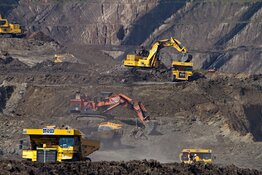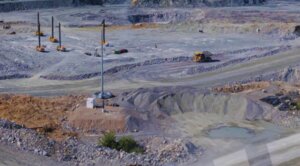Michael Fowler: LOM Ltd. is the oldest independent research boutique on Bay Street. It's been around for 40 years or so. What we are today is an institutional broker that focuses on small- to mid-cap mining issues. We also do high tech and biotech.
TGR: There is certainly a lot of room for growth in those sectors. Today, we're focusing on potential takeovers and mergers among Canadian junior gold companies. Last week, Goldcorp Inc. (TSX:G; NYSE:GG) sold its 10% stake in Osisko Mining Corp. (TSX:OSK) for $530 million. What did you make of that deal?
MF: I think it was telegraphed by Goldcorp to some degree, but what interests me is the timing of that transaction. I suspect that Goldcorp probably didn't want to wait until Osisko's Canadian Malartic mine in Quebec went into production. Mines that go into production have huge amounts of risk. Also, I would speculate that Goldcorp is certainly in the market for other assets. It's an interesting transaction.
TGR: Well, it's not like Goldcorp is cash-poor. Have you heard anything on Bay Street about potential targets?
MF: Goldcorp is reviewing targets all the time. I wouldn't be surprised to see the company pop its head up and look at Ventana Gold Corp. (TSX:VEN), for example, even at this late stage. There are other targets that it also might go after, which might suit its portfolio. I haven't heard of anything specific.
TGR: One common tack of majors like Goldcorp or mid-tier producers like Agnico-Eagle Mines Ltd. (TSX:AEM; NYSE:AEM) is to take a stake in a junior, get a look at the drill core and the deposit models and get a seat on the board. Do you know if Goldcorp has any seats on junior boards?
MF: I'm not aware of any particular boards on which the company sits. I wouldn't be surprised if it had stakes under the 5% threshold, which it doesn't have to report. The company took an equity interest in Gold Eagle Mines, which it took over a couple of years ago. I wouldn't be surprised if it had equity stakes all around the industry actually.
TGR: Despite about a 30% upswing in the gold price over last year, Goldcorp shares traded between $37 and $49. Over the same period, it's a similar story with Barrick Gold Corporation (TSX:ABX; NYSE:ABX) with its shares roughly trading from $37–$56. Those aren't bad gains but if Goldcorp were to take over something substantial, would that dramatically move the needle with those majors? Or are we going to need a merger of a couple of those large gold companies for that to happen?
MF: First of all, let's talk about mergers of big gold companies. In my opinion, that really doesn't create any value. You can look at Barrick Gold as an example. Since 1993, Barrick really hasn't created much in terms of shareholder value, despite several large takeovers. Although mergers may occur, I think the big gold companies realize that getting too big is not all that advantageous.
Secondly, a gold company would be more likely to take over a deposit, because there's great value enhancement from taking an undeveloped, or developed, project through to production. Companies gain accretion from that; they just can't pay too much for those assets. Some big gold companies have been paying a high price for some of those assets and may not benefit much from the acquisitions. Goldcorp's Andean Resources acquisition is a good example. Gold producers are going to be active in the mergers and acquisitions market. They're going to acquire because there's a huge amount of cash on their balance sheets.
TGR: You mentioned Goldcorp buying Gold Eagle, but there have been some other transactions in Canada's junior gold space. In 2011, Osisko took out Brett Resources, and Kinross Gold Corp. (TSX:K; NYSE:KGC) bought Underworld Resources. In 2007, Agnico acquired Cumberland Resources and its Meadowbank gold project, which is now a gold mine in Nunavut. The latter deals involved mid-tier producers buying some promising gold projects in mining-friendly jurisdictions. Do you see more of these deals happening in 2011? Is that part of your investment thesis in terms of your coverage sector?
MF: Not really. I do see some potential takeovers by those sorts of companies, though. Detour Gold Corporation (TSX:DGC) might be an example. Its shares are very highly priced; therefore, it may take over lower-priced or lower-valued shares of another company in an all-share takeover.
I see the Osisko-Brett takeover as being a weak transaction. You don't tend to get a non-producer taking over another non-producer unless it has some risks associated with its own deposit being brought into production. The biggest upside for Osisko, in my view, would've been just to get its mine into production and not bother taking over other producers. I see that type of transaction as being rather sporadic. If there are takeovers, we're more likely to see a big gold producer or a mid-sized gold producer taking over a company that has a gold project close to the feasibility-study stage.
TGR: That's twice you've alluded to potential problems with Osisko's Canadian Malartic Mine. Do you believe there could be issues there?
MF: It's not that I believe there are fundamental problems for Osisko at Malartic. It's just that the company is mining a very low-grade deposit. If it's wrong on the grade that goes through the mill by 10%, then there's a lot of risk associated with it. There aren't that many open-pit gold deposits in Canada. I just find Goldcorp's timing in disposing of its shares interesting.
TGR: I would suspect that people like Osisko CEO Sean Roosen were none too happy with Goldcorp selling at this point, but let's move on to your coverage area and some small- and micro-cap names. You have a Speculative Buy rating on Fire River Gold Corp. (TSX.V:FAU; OTCQX:FVGCF) with a 12-month target price of $1.40. Considering the company is currently trading at around $0.53, that would be a gain of more than 210%. FAU is scheduled to relaunch production at the Nixon Fork Gold Mine in Alaska later this year. It bought the property after Saint Andrews Goldfields (TSX:SAS) was forced to close the mine in 2007 due to production problems. What makes you think Fire River has solved those problems?
MF: First of all, let's talk a little bit about St. Andrew. These comments are not really about today's St. Andrew because it's a different company now than in the past. But previously, St. Andrew had a pretty poor mining record. It also had problems with another project in the Timmins area of Ontario. I think that in those days St. Andrew's management was heavily weighted toward miners and less so toward geological engineers. The real problem at Nixon Fork was the lack of understanding of the deposit's geology. By the way, St. Andrew wasn't the only operator of the Nixon Fork Mine. Consolidated Nevada Goldfields Corporation (now Real del Monte Mining Corporation, a private company) operated the mine in the 1990s and actually made profits.
Moving forward to today, what can Fire River do differently from St. Andrew? One point is that it has a little bit of time. Financial obligations forced the company to produce, but Fire River actually has time to do some drilling. It's currently doing 28,000 meters of drilling in order to really understand the Nixon Fork ore body—that is the key to that operation. It's a very low-tonnage mine, so the company needs to have good control over the geology. That's the focus that Fire River is taking and I'm betting that it's going to get that right. The mere fact that there are very high-grade resources is going to give Fire River some leeway if it has any problems associated with the grade.
TGR: In your discounted cash flow (DCF) model for Fire River, you used a 5% discount rate and a $1,400/oz. gold price. I would say, generally, that the discount rate is a little bit low and the gold price is probably a little high. Why did you choose those numbers?
MF: The discount rate has always been a topic of conversation in the industry. What discount rate does one use? Traditionally, analysts use 5% discount rates for gold companies; and, actually, some use 0% as a discount rate. The reason is that the DCF method is very inflexible. It doesn't really tell you the potential for increases in reserves or resources or the potential for rises in the gold price. Therefore, if you do a DCF of 5% on a lot of producers, you'll find that they actually trade at premiums to that discount rate. In fact, I use 5% on just about every company out there.
TGR: What about the $1,400/oz. gold price?
MF: I don't think that's a bad gold price to use. I think we're going to soon see gold closer to $1,400/oz., and then a year later, it will be over $1,400/oz. I'm bullish on gold. I don't see any reason to change that view. I guess the biggest risk on gold is interest rate hikes. I just don't think that's going to happen. I think that $1,400/oz. is a very good price to use; but, even if gold went to $900/oz., I still believe Fire River would make a small but reasonable profit.
TGR: Fire River released its Preliminary Economic Assessment (PEA) of the Nixon Fork Project on February 17. We can also expect to see drill results from that 28,000m drill program you mentioned. What are you expecting from that scoping study?
MF: I'm expecting a robust scoping study. It may not show the same level of net asset value (NAV) that we calculated because the NAV that we calculated assumes some additions to the resource. So I think the scoping study will be a little bit less than the NAV we've used. The other thing is that the scoping study will use $1,200/oz. gold, not $1,400/oz. gold. Nevertheless, I think we're going to see a fairly robust situation. I do have to warn people that we may not see the same level of value that we calculated because we used a higher gold price. We also assumed that Fire River would find extra resources through the drilling that's taking place.
TGR: You're projecting $36 million in cash flow in 2012 once Nixon Fork reaches production. Do you believe Fire River could become a takeover target at that point, or is that scenario is more likely before Fire River reaches production?
MF: No, I don't think it's going to happen before the company reaches production. I want to point out that there's a lot of skepticism out there about this story. We're banking on it working out. That is probably one of the most fundamental reasons to buy the stock right now. It could be a takeover target if it's successful in production. But I have a feeling that it might be the acquirer down the road rather than the acquired. Fire River will be a relatively small producer; if it works out as we expect, the company may be in the market for a merger with another small producer.
TGR: That's certainly not the only company you cover. You have Speculative Buy ratings on Richfield Ventures Corp. (TSX.V:RVC), Clifton Star Resources Inc. (TSX.V:CFO) and Fortune Minerals Limited (TSX:FT). Why do you like those stories?
MF: Let's start with Richfield, which has drilled about 100 holes in Blackwater Gold Project—a low-grade, bulk-tonnage target. It's had consistently good results and it looks to me as though we're heading toward 4 million ounces (Moz.) or more in the ground for that deposit. We haven't had a resource estimate from the company, but the company is planning a PEA in the fall. I suspect that we're going to get some very good numbers from that study. Richfield is trading at a fairly low valuation, and with further drilling I expect to see that increase.
TGR: Richfield has had some impressive drill results at Blackwater. One was 72 meters of 1.6 grams per ton (g/t) gold; another returned 183m of just a little over 1 g/t gold. Those results would indicate a bulk-tonnage target, but what is the ownership situation with Silver Quest Resources Ltd. (TSX.V:SQI)? Richfield optioned that property from Silver Quest, but it's not quite that clear-cut, is it?
MF: Well, it's pretty clear-cut. The northern half of the project is actually part of a 75/25 joint venture (JV) with Silver Quest. But the bottom half of the project is 100% owned by Richfield Ventures and most of the drilling has been on the ground that Richfield owns. Now, I suspect that the two parties are talking to try to get the best value for their shareholders from that deposit. In the future, I think you may well see some news regarding a revised deal with Silver Quest for the northern half of the deposit.
TGR: Please tell us about Clifton Star.
MF: Clifton Star Resources is working on the Destor Porcupine fault zone on the Quebec side of the border with Ontario. The Destor Porcupine fault has produced more than 100 Moz. gold, so we're onto a great location. The infrastructure is there and it's in Quebec, the best location in the world for finding a mine.
Osisko is actually earning a 50% interest in this project. Clifton Star is trying to find a large, bulk-tonnage deposit. At the moment, it has close to 3 Moz. gold in terms of NI 43-101 reports. But, quite frankly, I think we could be well over 5 Moz. as a result of the drilling done with Osisko. Again, this is an undervalued situation. I see some upside potential in Clifton Star.
TGR: Maybe one more for our readers?
MF: I'd just like to mention Fortune Minerals, which is a different type of story. Fortune has two deposits. One is a gold-cobalt-bismuth deposit in the Northwest Territories, which has about 1 Moz. gold. The other is a coal project in BC. The coal project is interesting because coal is very hot right now. The price of metallurgical coal is about $250/ton. Fortune's coal contracts are being written as we speak, so that coal deposit is very valuable. Fortune's NICO Deposit in the Northwest Territories is totally undervalued in terms of our DCF model. I would say there's about $5 of value in those two projects, and that's not even using today's prices of coal, cobalt or gold. We are really excited about that company.
TGR: Most of the companies you like have projects in Canada, as you said, it's one of the most mining-friendly places in the world.
MF: I like Canada. Richfield is in a good spot; it's close to infrastructure. Clifton Star is close to infrastructure. Infrastructure at Fortune Minerals, however, is not as good; though it is in Canada. I'm very bullish on Canada.
TGR: What can our readers expect in terms of the number, or size, of deals that could happen this year? Of course, it's pure speculation but what do you think will happen?
MF: I think there are going to be a lot of deals in the $1–$10 billion range and maybe even down to the $500 million range. I expect a lot of activity. The big gold producers are looking for good deposits with some upside potential, but one of the best ways of generating shareholder value is through exploration, not acquisition—resource expansion by the drill bit. So, look for bigger exploration budgets from these gold producers. It makes a lot of sense economically; it just takes time to generate a mineable deposit.
TGR: Thank you for talking with us today, Michael.
Michael Fowler, senior mining analyst with Loewen, Ondaatje, McCutcheon Ltd., has worked in the investment industry since 1987 as a base and precious metals mining analyst for numerous high-profile firms. His coverage list includes the major North American gold mining companies. Previously, Michael worked as a geophysicist involved in mineral exploration for 10 years. He was involved in the discovery of the high-grade Cigar Lake uranium mine in Northern Saskatchewan in the early 1980s. Michael holds an MBA from Cranfield University, UK, an M.Sc in mineral exploration from Leicester University, UK, as well as a B.Sc in geology with geophysics from Liverpool University, UK. He is a member of the Institution of Materials in the UK and a member of the Canadian Institute of Mining and Metallurgy.
Want to read more exclusive Gold Report interviews like this? Sign up for our free e-newsletter, and you'll learn when new articles have been published. To see a list of recent interviews with industry analysts and commentators, visit our Expert Insights page.
DISCLOSURE:
1) Brian Sylvester of The Gold Report conducted this interview. He personally and/or his family own shares of the following companies mentioned in this interview: None
2) The following companies mentioned in the interview are sponsors of The Gold Report: Goldcorp, Detour Gold, Fire River Gold and Richfield Ventures.
3) Michael Fowler: I personally and/or my family own shares of the following companies mentioned in this interview: None. I personally and/or my family am not paid by the following companies mentioned in this interview: None. LOM has acted as a financial advisor to: Fire River Gold, Richfield Ventures Corp. and Fortune Minerals and has received a fee for services rendered.













































